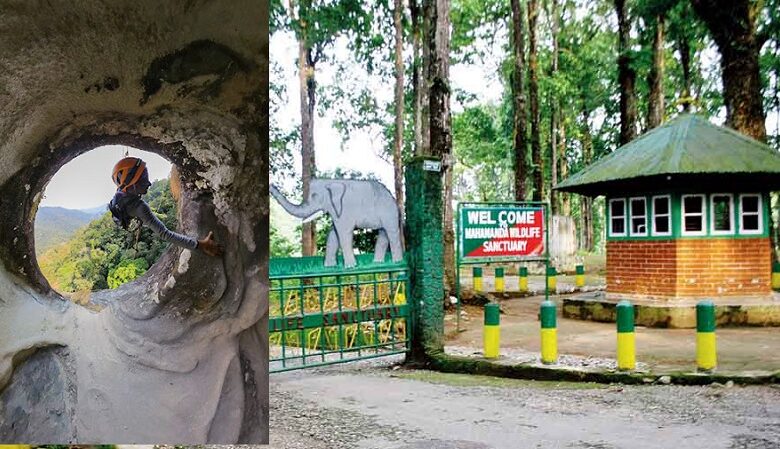Ancient Royal Hideouts Known As Raja-Rani Pahar’s Secret Caverns Are Located At Mahananda Wildlife Sanctuary

Travel writer Hirak Nandi discovered a Lepcha tribe local tale in the middle of the 1990s while conducting research for the West Bengal Forest Department in the Mahananda Wildlife Sanctuary, which is situated in the foothills of the Himalayas. Sikkim, which historically included the modern-day regions of Darjeeling and Kalimpong, is home to the indigenous Lepcha people. According to legend, the local Lepcha royals used the hidden cave hideouts at Raja-Rani Pahar during invasions and attacks. There isn’t a lot of information available about Lepcha kings and queens because their past hasn’t been well-written. The first Lepcha monarch, according to the majority of historians, was Thorve Pano, though there is debate over when exactly he ruled, which has been put anywhere between the 15th and the 17th century. The last Lepcha king was defeated and killed in 1608, bringing the dynasty to an end after a few more years.
Local Lepcha people who took part in the poll revealed to Nandi that the hideout was really just a tiny opening high up on the Raja Pahar. Nandi noted that the only way to get there is by expert mountain climbing. The cave stayed an unattainable goal because the team was unprepared for that.
Anindya Mukherjee, a climber, was inspired by Nandi’s account of it in a well-known Bengali newspaper.
Mukherjee had just begun his career as a professional mountaineer at that time, having abandoned his position as a medical representative. Mukherjee traveled to the Mahananda Sanctuary with a small group and tools for rock climbing. The local Lepchas cautioned him against going any further and claimed that the forest contains enigmatic plants whose aroma causes people to experience hallucinations and that there have even been reports of people falling off cliffs. Mukherjee and his crew ignored the warnings and headed for the cave, but things did not go as planned. Mukherjee took a bad tumble as they were approaching. He was about to die, but a cactus sticking out of the sheer precipice saved him. Mukherjee carried on with his global expedition even after the near-death experience, but the location of the hidden royal Lepcha hideaway eluded him for more than two decades.
Mukherjee returned in February 2023 with a six-person team, and the locals once more discouraged them from going on the cave search and even told them a story about a man who had fallen off the precipice in the past. Clearly, Mukherjee’s appearance has changed over the past two decades. The residents were more than shocked when he admitted that he was the person who had avoided death more than 20 years prior.
The crew established a base camp in the Latpanchar Bungalow after securing the required approvals from the forest department. The distance between the bungalow and the foot of the Raja and Rani Pahar was about two hours, but the area was covered in dense vegetation and had a variety of wildlife. The team’s exploration was escorted by armed forest guards.
The crew conducted a preliminary survey on February 13 and discovered no caves on the Rani Pahar, but they could see the cave high up on the Raja Pahar’s sheer rock face. The cave was nearly 200 feet above street level and impossible to access. A drone could not be used because of the dense foliage. Rappelling down from the top was therefore the only remaining choice. By using ropes and other tools like a harness and descenders, the technique of rappelling allows people to descend close to a vertical rock wall. On February 14, the team discovered a trail going to the summit on the mountain’s backside. They attempted several rappels to get into the cave after reaching the summit without much success, but they were able to locate the ideal rappel spot during the process.
On February 16, following a day of rest, the party was once more at the summit of the Raja Pahar. Mukherjee agreed to descend by climbing. When he got to the cave’s mouth, he discovered himself hanging in midair, almost ten feet from the tunnel. He eventually entered the royal shelter cave after several unsuccessful attempts and swinging like a pendulum. It was just a small hollow in the hill that could only hold three to four persons; nothing particularly regal. Mukherjee brought back dust samples from the cave floor for scientific study despite not finding any signs of human habitation. Another similar cave is only four feet distant, and Mukherjee was able to enter it as well.
It makes sense why the royals only used these caverns as a temporary refuge during outside invasions. The king, queen, and members of their close family most likely entered the cave using rope ladders. The same method was used to bring them back after the attack was over.
Mukherjee thinks the investigation is just getting started even though it is over. More historical and scholarly research, in his opinion, is necessary. Archaeologists can search for artifacts left behind in the cave, geologists can determine how old the caves are, and anthropologists can cast light on the Lepcha way of life at the time. Mukherjee is prepared to assist these skilled individuals in exposing the Lepcha royals’ covert lair.
News Mania Desk






